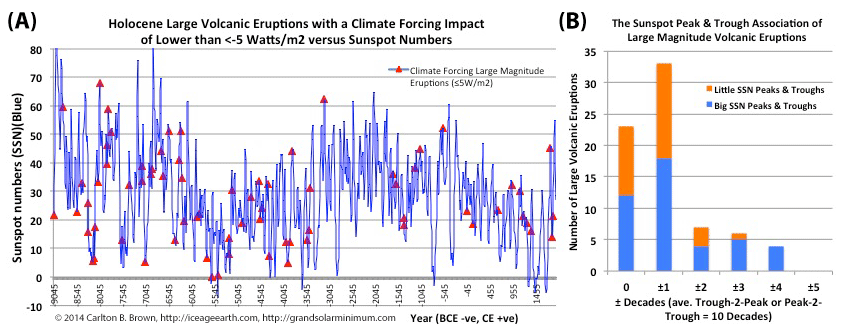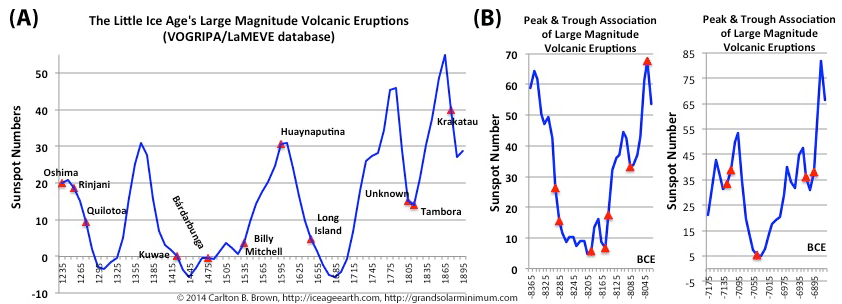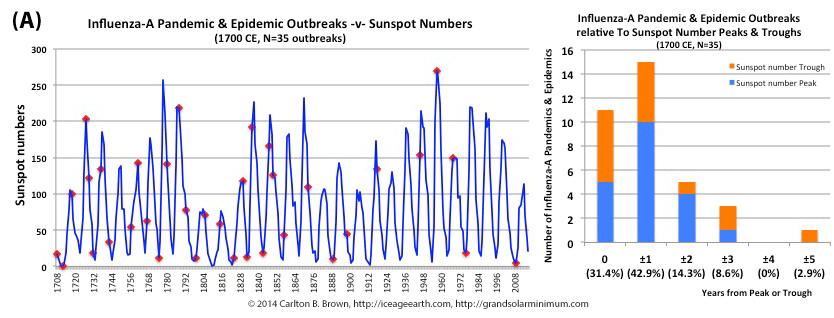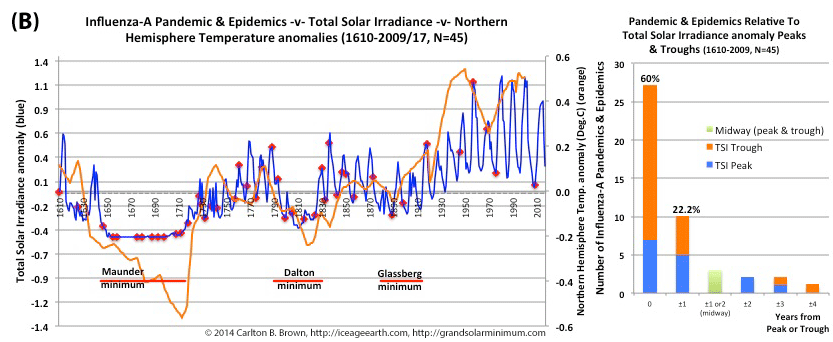
Catastrophic large magnitude volcanic eruptions during a grand solar minimum
The risk of catastrophic large magnitude volcanic eruptions increases during a grand solar minimum and maximum of sun pot numbers. Earth then rapidly cools. Grand solar minima and maxima (±1 decade) represent high-risk periods for climate-forcing volcanic eruptions—the kind that cool the planet, and cause centennial-scale glacier ice accumulation and global famine.
The volcanic eruption data detailed in the figure above was derived from Greenland’s GISP2 sulphate record (after applying a threshold filter) and was used to estimate the number of large magnitude or climate-forcing volcanic eruption events. In this manner, the 73 largest climate-forcing volcanic eruptions were selected covering the last 11,000 years. The 73 large magnitude volcanic eruptions were plotted against the sunspot numbers (NOAA provided). Figure B) Seventy-seven percent (56/73) of climate-forcing volcanic eruptions occurred at or within a decade of a grand solar minimum (i.e., a deep sunspot number trough) or grand solar maximum (i.e., a large sunspot number peak). This resulted in the skewed distribution of the eruptions in the zero and ±1 decade groups relative to the ±2–5 decade groups. This above described relationship is not evident for smaller volcanic eruptions. Three-quarters of these large climate-forcing eruptions occurred when the 500-year average sunspot number fell below 37.[i]
A similar result was obtained by plotting the 67 total Volcanic Explosivity Index 6 and 7 eruptions (scale of 1 to 8, with 7 being Rinjani or Tambora-like i.e., globally catastrophic) from the Volcano Global Risk Identification and Analysis Project (VOGRIPA) database against 11,000 years of sunspot numbers. This analysis showed that 82 percent of all VEI 6 or 7 events occurred at or within a decade of a sunspot number peak or trough. Three-quarters of these VEI 6 and 7 events occurred when the 500-year average sunspot number fell below 34.[ii]
Grand solar minima and maxima (±1 decade) represent high-risk periods for climate-forcing volcanic eruptions. Earth has entered a high-risk grand solar minimum period for climate-forcing volcanic eruptions—the kind that cools the planet, and causes centennial-scale glacier ice accumulation and global famine.
When viewing Figure A above, which depicts sunspot numbers between 9104 BCE and 1895 CE, it becomes obvious that sunspot cycles constitute a natural oscillator (more frequently associated with climate forcing volcanic eruptions). The mean sunspot number trough-to-peak or peak-to-trough duration was ten decades (standard deviation 4.7 and range 3–25 decades). This solar activity oscillator is similar to the temperature oscillations (and durations) evident in the Arctic ice core temperature data,[iii] albeit the two are not always in phase with each other. The duration of both the larger sunspot number oscillation and larger temperature oscillations is typically one to two centuries from trough-to-trough.
Could grand solar minima and maxima of sunspot numbers (solar magnetism) be an important cause of centennial-scale climate oscillations and centennial-scale glacier ice accumulation? What is very clear from the data is that the sun has multiple levers on the climate system, to control millennial-, centennial-, and decadal-scale climate change and climate risks.
Click on this page and download a free copy of my book “Revolution: Ice Age Re-Entry,” and read more about this topic in Chapter 5 and answers to the above question.
[i] Data: (1) Takuro Kobashi et al., 2017, “Volcanic influence on centennial to millennial Holocene Greenland temperature change.” Scientific Reports, 7, 1441. doi: 10.1038/s41598-017-01451-7. Data provided by the National Centers for Environmental Information, NESDIS, NOAA, U.S. Department of Commerce. https://www.ncdc.noaa.gov/paleo-search/study/22057. Data accessed 21/08/2018. (2) Solanki, S.K., et al. 2004. “An unusually active Sun during recent decades compared to the previous 11,000 years.” Nature, Volume 431, No. 7012, 1084-1087, 28 October 2004. Data: Solanki, S.K., et al. 2005. “11,000 Year Sunspot Number Reconstruction.” IGBP PAGES/World Data Center for Paleoclimatology. Data Contribution Series #2005-015. NOAA/NGDC Paleoclimatology Program, Boulder CO, USA. https://www.ncdc.noaa.gov/paleo-search/study/5780. Downloaded 05/06/2018. Personal Research: Figure 5.1.A: Using the above-cited climate-forcing volcanic eruption data a quantitative filter was utilized to identify the largest climate forcing eruptions, and to group all eruption events into climate-forcing categories. Each volcanic eruption started with the first data point in a group series, and this group series magnitude was represented by the maximum volcanic forcing magnitude data point (i.e., the most negative Watts/meter-squared value) for that group series (i.e., a 1-year value from within a range of 1-10 years). This was completed for the entire time series (11,054 years). In this manner 403 volcanic events were identified over 11,054 years. The eruption events were preliminarily assigned to groups based on their maximum solar forcing impact, as follows: Group-1, ≤-10 W/m2 (N=23). Group-2, -5 to <-9.99 W/m2 (N=50). Group-3, -2 to <-4.99 W/m2 (N=89). Group-4, 0 to <-1.99 W/m2 (N=241). Volcanic events were then grouped and compiled into 500, 400, and 300 year bin totals spanning the last 5,000, 8,000, and 11,000 years. The average sunspot numbers were calculated for each bin period. A goodness of fit and outlier tests were conducted for all groupings. Pearson and Spearman rank correlations and their significance levels were calculated for each 5,000, 8,000, and 11,000 year periods to help understand if significant relationships existed or not. Results: The 500-year bin totals generated the highest and most significant correlations, and the 8,000 year period of review maximized the correlation coefficient. The correlation values were reduced for 11,000-year period versus the 8,000-year period, and were marginally smaller for 400-year bins, and much smaller for 300-year bins (Data not shown) compared with the 500-year bins. On this basis, the 8,000-year duration and 500-year bin totals represented the optimum grouping which maximized the duration of the relationship i.e., since the Holocene Climate Optimum. The 8,000-year data summary is tabulated above (at the start of the endnotes, referencing this endnote). The outcome of this analysis was to compile Groups 1 and 2 into a single group and set the climate forcing eruption threshold at ≤ -5.0 Watts/meter-squared i.e., large volcanic eruptions. All 73 large climate-forcing volcanic eruptions were plotted against the above-cited Solanki et al. sunspot numbers to produce Figure 5.1.A’s graphic. Figure 5.1.B: The 73 climate-forcing eruptions selected above were tabulated alongside the above-cited Solanki et al. sunspot numbers in the year of the eruption’s occurrence. The number of periods (at a 10-year resolution) was counted to the previous or next grand solar minimum or maximum for all Group 1 eruptions. The data was used to derive Figure 5.1.B.
[ii] Data: (1) Helen Sian Crosweller et al., “Global database on large magnitude explosive volcanic eruptions (LaMEVE).” Journal of Applied Volcanology Society and Volcanoes 20121:4. https://doi.org/10.1186/2191-5040-1-4. Volcano Global Risk Identification and Analysis Project database (VOGRIPA), British Geological Survey. Data Access: http://www.bgs.ac.uk/vogripa/. Data downloaded 07/05/2018. (2) S.K. Solanki et al., 2004, “An unusually active Sun during recent decades compared to the previous 11,000 years.” Nature, Volume 431, No. 7012, 1084-1087, 28 October 2004. Data: S.K. Solanki et al., 2005, “11,000 Year Sunspot Number Reconstruction.” IGBP PAGES/World Data Center for Paleoclimatology. Data Contribution Series #2005-015. NOAA/NGDC Paleoclimatology Program, Boulder CO, USA. https://www.ncdc.noaa.gov/paleo-search/study/5780. Downloaded 05/06/2018. Personal Research: A total of 67 VEI 6 and 7 eruptions were extracted from the LaMEVE database. These were plotted alongside the above-cited Solanki et al. sunspot numbers. The number of 10-year periods was counted from each eruption to the previous or next sunspot number peak or trough. The data is tabulated above, at the start of the endnotes and referencing this endnote. Results: 82 percent of VEI 6-7 eruptions occurred at or within one decade of a sunspot number peak or trough. This peak and trough occurrence coincides with either a grand solar maximum or minimum, or a smaller sub-peak or sub-trough of sunspot numbers.
[iii] B.M. Vinther et al., 2009, “Holocene thinning of the Greenland ice sheet.” Nature, Vol. 461, pp. 385-388, 17 September 2009. National Centers for Environmental Information, NESDIS, NOAA, U.S. Department of Commerce. Greenland Ice Sheet Holocene d18O, Temperature, and Surface Elevation. doi:10.1038/nature08355. https://www.ncdc.noaa.gov/paleo-search/study/11148. Downloaded 05/05/2018.






Recent Comments